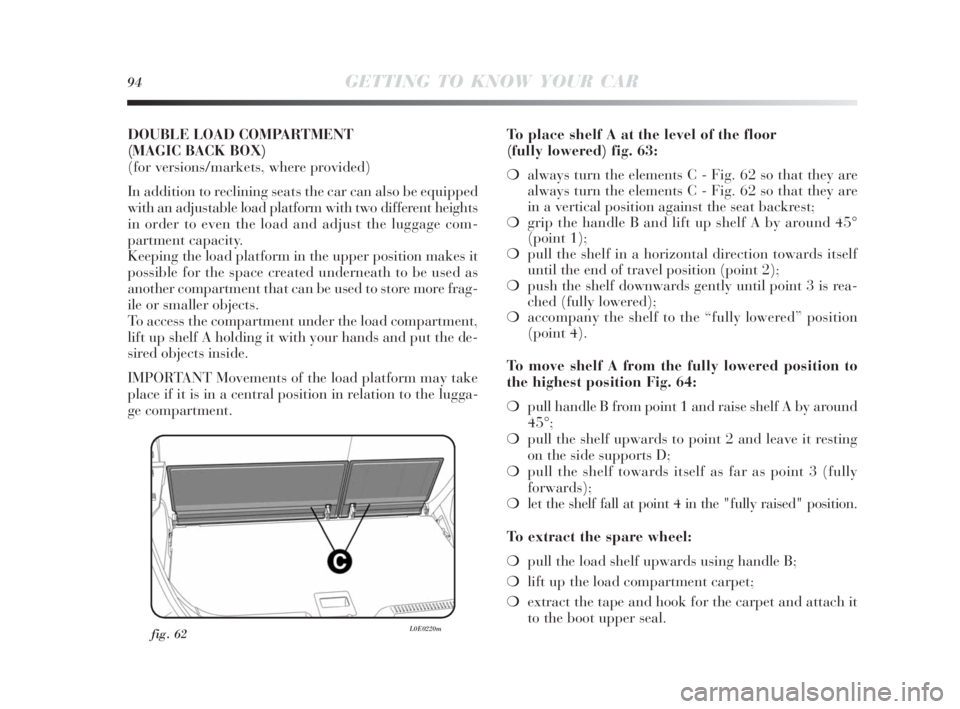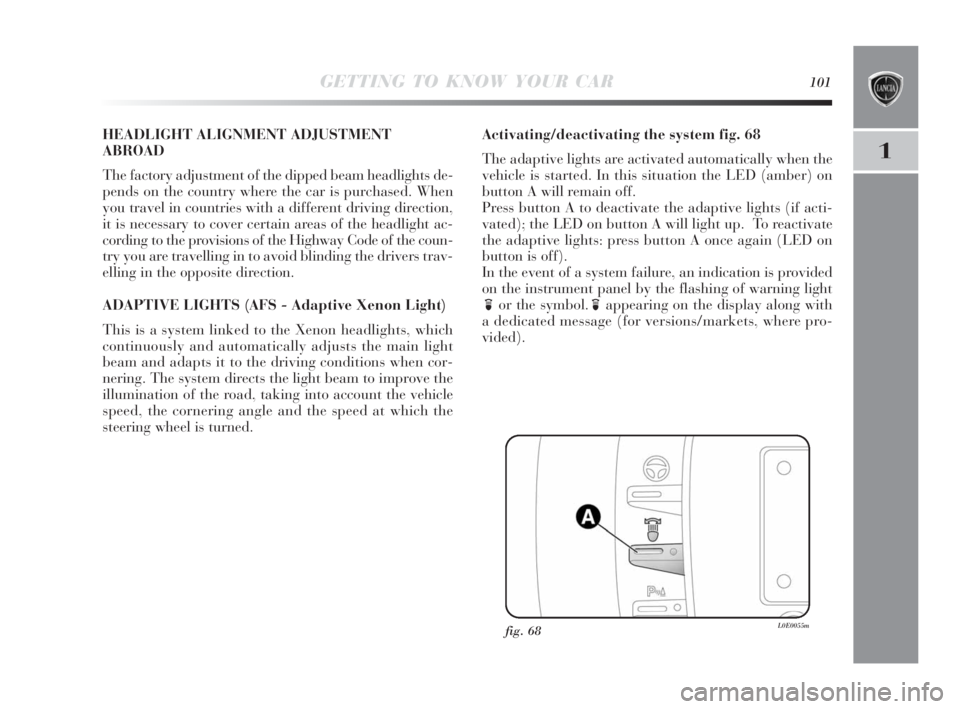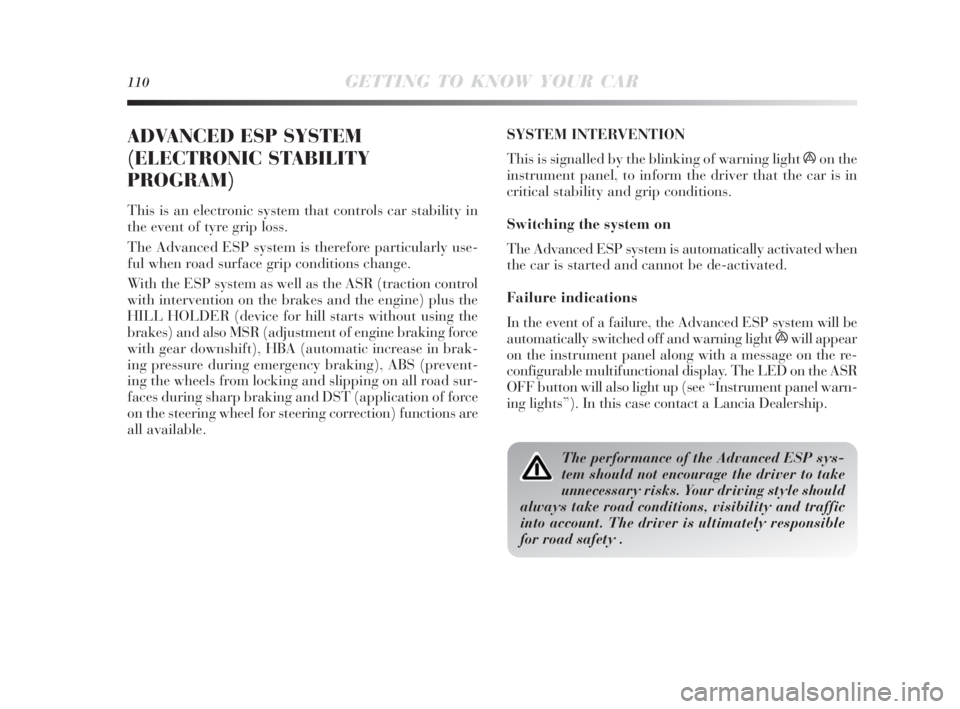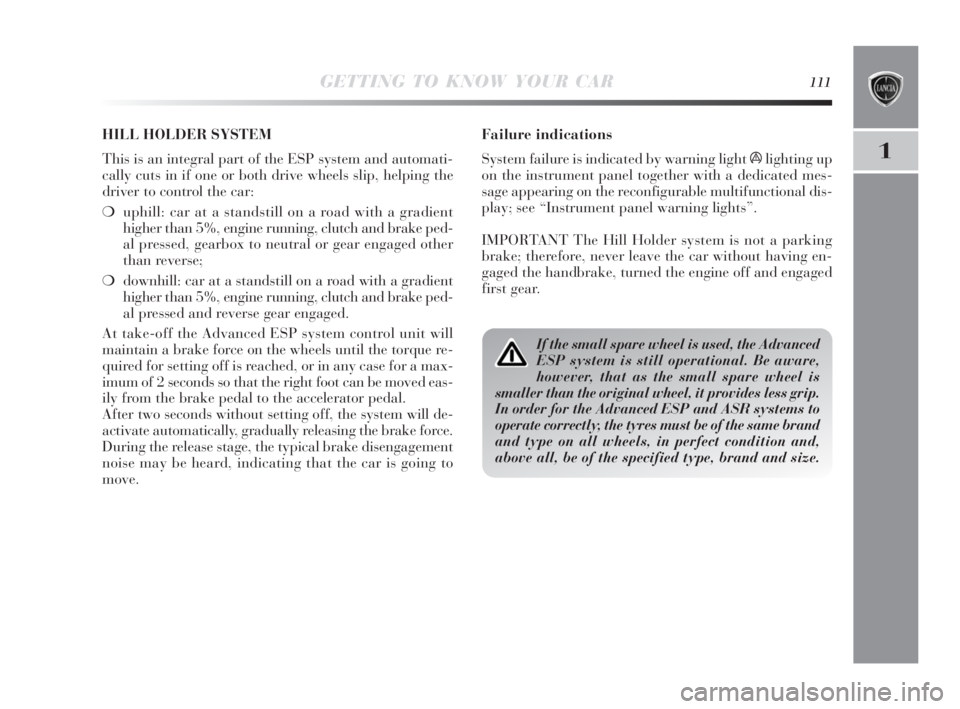wheel Lancia Delta 2010 Owner handbook (in English)
[x] Cancel search | Manufacturer: LANCIA, Model Year: 2010, Model line: Delta, Model: Lancia Delta 2010Pages: 276, PDF Size: 5.31 MB
Page 95 of 276

94GETTING TO KNOW YOUR CAR
fig. 62L0E0220m
DOUBLE LOAD COMPARTMENT
(MAGIC BACK BOX)
(for versions/markets, where provided)
In addition to reclining seats the car can also be equipped
with an adjustable load platform with two different heights
in order to even the load and adjust the luggage com-
partment capacity.
Keeping the load platform in the upper position makes it
possible for the space created underneath to be used as
another compartment that can be used to store more frag-
ile or smaller objects.
To access the compartment under the load compartment,
lift up shelf A holding it with your hands and put the de-
sired objects inside.
IMPORTANT Movements of the load platform may take
place if it is in a central position in relation to the lugga-
ge compartment.To place shelf A at the level of the floor
(fully lowered) fig. 63:
❍always turn the elements C - Fig. 62 so that they are
always turn the elements C - Fig. 62 so that they are
in a vertical position against the seat backrest;
❍grip the handle B and lift up shelf A by around 45°
(point 1);
❍pull the shelf in a horizontal direction towards itself
until the end of travel position (point 2);
❍push the shelf downwards gently until point 3 is rea-
ched (fully lowered);
❍accompany the shelf to the “fully lowered” position
(point 4).
To move shelf A from the fully lowered position to
the highest position Fig. 64:
❍pull handle B from point 1 and raise shelf A by around
45°;
❍pull the shelf upwards to point 2 and leave it resting
on the side supports D;
❍pull the shelf towards itself as far as point 3 (fully
forwards);
❍let the shelf fall at point 4 in the "fully raised" position.
To extract the spare wheel:
❍pull the load shelf upwards using handle B;
❍lift up the load compartment carpet;
❍extract the tape and hook for the carpet and attach it
to the boot upper seal.
001-142 Delta 3ed gb 30-11-2009 11:22 Pagina 94
Page 102 of 276

GETTING TO KNOW YOUR CAR101
1
HEADLIGHT ALIGNMENT ADJUSTMENT
ABROAD
The factory adjustment of the dipped beam headlights de-
pends on the country where the car is purchased. When
you travel in countries with a different driving direction,
it is necessary to cover certain areas of the headlight ac-
cording to the provisions of the Highway Code of the coun-
try you are travelling in to avoid blinding the drivers trav-
elling in the opposite direction.
ADAPTIVE LIGHTS (AFS - Adaptive Xenon Light)
This is a system linked to the Xenon headlights, which
continuously and automatically adjusts the main light
beam and adapts it to the driving conditions when cor-
nering. The system directs the light beam to improve the
illumination of the road, taking into account the vehicle
speed, the cornering angle and the speed at which the
steering wheel is turned.Activating/deactivating the system fig. 68
The adaptive lights are activated automatically when the
vehicle is started. In this situation the LED (amber) on
button A will remain off.
Press button A to deactivate the adaptive lights (if acti-
vated); the LED on button A will light up. To reactivate
the adaptive lights: press button A once again (LED on
button is off).
In the event of a system failure, an indication is provided
on the instrument panel by the flashing of warning light
for the symbol.
fappearing on the display along with
a dedicated message (for versions/markets, where pro-
vided).
fig. 68L0E0055m
001-142 Delta 3ed gb 30-11-2009 11:22 Pagina 101
Page 103 of 276

102GETTING TO KNOW YOUR CAR
DST SYSTEM
(Dynamic Steering Torque)
This system is built into the advanced ESP control unit
and provides steering corrections via the electric power
steering during driving. The system applies torque to the
steering wheel, increasing the feeling of safety, maintain-
ing control and reducing the impact of advanced ESP sys-
tem intervention.
Fault signalling
In the event of any operating faults occurring, the sys-
tem switches off automatically and the èwarning light is
lit up on the display together with a dedicated message.
In this case contact a Lancia Dealership.
SPORT FUNCTION
(for versions/markets, where provided)
The vehicle can be equipped with a system that allows you
to choose between two driving modes: normal and sport.
Press the SPORT button fig. 69 to set the sport driving
mode. This is characterised by increased acceleration re-
sponse and increased force required at the steering wheel
to obtain a more sporty drive.
fig. 69L0E0058m
001-142 Delta 3ed gb 30-11-2009 11:22 Pagina 102
Page 104 of 276

GETTING TO KNOW YOUR CAR103
1
When the function is active, “S” is displayed on the in-
strument panel. Press the button once again to deacti-
vate the function and return to the standard driving mode.
IMPORTANT The function is activated about 5 seconds
after the SPORT button is pressed.
IMPORTANT The steering may become slightly stiff fol-
lowing parking manoeuvres involving a lot of steering.
This is normal and caused by a system to prevent the mo-
tor from overheating. No servicing is required. The pow-
er steering system will return to normal operation the next
time the car is used.Under no circumstances should after-market
operations be carried out involving steering
system or steering column modifications (e.g.:
installation of anti-theft device). This could nega-
tively affect performance and safety, cause the lapse
of the warranty and also result in vehicle non-com-
pliance with type-approval requirements.
Before servicing the car, switch off the engine
and remove the key from the ignition device to
activate the steering lock. This is especially
important when the car wheels do not touch the
ground. If this is not possible (if the key must be on
MAR or the engine must be running), remove the
main fuse which protects the electric power steering.
On some versions, with the CITY function ac-
tivated, the SPORT function is not available.
To activate the SPORT function, deactivate the
CITY function and vice versa, because they are reci-
procally incompatible.
001-142 Delta 3ed gb 30-11-2009 11:22 Pagina 103
Page 107 of 276

106GETTING TO KNOW YOUR CAR
OPERATION
The system is not activated when the vehicle is started.
It is only activated when button A-fig. 71 on the dash-
board is pressed. Activation is confirmed by the lighting
up of the LED on the button and a dedicated message ap-
pearing on the display. Once it is turned on the system will
recognize the operating conditions which is signalled to
the driver by the LED located in the button flashing and
the symbol
ein the amber coloured panel in the instru-
ment panel display flashing too. Once the system has
recognised the operating conditions, it becomes active.
When this happens: the
eicon on the display goes out
and the LED on the button remains on constantly.
IMPORTANT If the operating conditions are no longer
present then the system will deactivate. This is signalled
to the driver by: the LED on the button and the amber
eicon on the display flashing.
OPERATING CONDITIONS FOR ACTIVATION
Once switched on, the system becomes active only if the
following conditions are present:
❍always keep at least one hand on the steering wheel;
❍vehicle speed between 65 km/h and 180 km/h;
❍presence of lane demarcation lines not deteriorated and
visible on both sides;
❍suitable visibility conditions;
❍straight road or wide curves;
❍visual field condition sufficient (safety distance from
vehicle in front). ACTIVATING/DEACTIVATING THE SYSTEM
When the system is active, if the vehicle nears one of the
side lane markings a torque is applied to the steering wheel
advising the driver of the direction the steering wheel needs
to the turned to stay in the present lane.
If the driver turns on the direction indicator in order to
change lanes or for overtaking, then the system will switch
off momentarily. If the driver wishes to change lanes with-
out turning the direction indicator on, then there will be
a warning from the steering wheel that they are about to
cross the line. If the driver continues with the manoeuvre
to change lanes, the system will be temporarily deactivated
and then switch back on again once it has recognized the
new driving lane. This temporary deactivation will be sig-
nalled to the driver by the LED in the button flashing and
by the symbol
ein the amber coloured panel in the in-
strument panel display also flashing.
001-142 Delta 3ed gb 30-11-2009 11:22 Pagina 106
Page 108 of 276

GETTING TO KNOW YOUR CAR107
1
SWITCHING OFF THE SYSTEM
Manual method
The system can be deactivated by pressing button A-fig. 71
on the dashboard.
Confirmation of system deactivation is signalled by the
LED on the button going out and a message 1-fig. 72 ap-
pearing on the display.
Automatic method
The system can be deactivated automatically (if the sys-
tem is required it will therefore need to be reactivated).
The driver is advised that the system has been turned off au-
tomatically by three consecutive acoustic signals and the mes-
sage 1 – fig. 72 in the instrument panel display after the fol-
lowing situations:
❍the driver does not keep his hands on the steering wheel
(indication 2-fig. 72 is shown on the instrument pan-
el and a buzzer sounds until the driver places his hands
back on the wheel. This is considered a dangerous con-
dition and the system is automatically deactivated);
❍triggering of the vehicle safety systems (ABS, ESP,
ASR, DST and TTC);
❍the driver sets the sports driving pressing the SPORT
button (for versions/markets, where provided).
WARNING: the system cannot be activated if the driver
has previously selected the sport driving mode. The im-
possibility of using the system will be communicated to
the driver by three consecutive beeps and by the displayed
message 1 in fig. 72.SYSTEM FAILURE
In the event of a malfunction, the system reports the fault
via a message 3-fig. 72 appearing on the display and a
buzzer sounding.
IMPORTANT
The driving advisor is unable to operate following a malfunc-
tion in any of the following safety systems: ABS, ESP, ASR,
DST and TTC.
In the presence of indistinct, overlapping or
missing lane markings, the lane assistance
function is unable to aid the driver and the
system will be deactivated.
The driving advisor is not an automatic dri-
ving system and cannot replace the driver in
controlling the vehicle trajectory. The driver
is personally responsible for maintaining a suitable
level of concentration as traffic and road conditions
require, and for safely controlling the vehicle’s tra-
jectory.
The operation of the lane assistance function may be com-
promised by adverse visibility conditions (rain, fog, snow),
extreme lighting conditions (solar glare, darkness) or dirt
or damage, even partial, to the windscreen in the area
around the video camera.
The area of the windscreen by the TV camera should not
be partly or totally obscured by objects (e.g. stickers, pro-
tective film, etc.)
001-142 Delta 3ed gb 30-11-2009 13:22 Pagina 107
Page 110 of 276

GETTING TO KNOW YOUR CAR109
1
System not activated
The system was acknowl-
edged and it is not activated
The system searches
for the operating
conditions
The system is activated and
the operating conditions
were acknowledged
The system has been en-
gaged and is immediately
activated
The system has been turned
off manually
The system has been turned
off automatically
The system warns the
driver to place their hands
on the steering wheel
The system is faulty:
go to a
Lancia Dealership
The system was not engaged
due to the sport drive mode
activation
TABLE SUMMARIZING SIGNALS DURING THE USE OF THE DRIVING ADVISOR
–
–
–
–
–
–
3 signals
Single prolonged
warning
Single
warning
3 signals–
eLit up, flashing
eLit up, flashing
–
–
–
–
eLit up, constantly
e! Lit up,
constantly
–
–
Driving Advisor
connected
–
–
Driving Advisor
connected
Driving Advisor
disconnected
Driving Advisor
disconnected
Keep your hands
on the wheel
Driving Advisor
unavailable see
handbook
Driving Advisor
disconnected
Status of the LED Message Status of the icon Acoustic Meaning
in the button in the display (fig. 71-72) on the display signal
Off
On, flashing
On, flashing
On, constantly
On, constantly
Off
Off
On, constantly
Off
Off
001-142 Delta 3ed gb 30-11-2009 11:22 Pagina 109
Page 111 of 276

110GETTING TO KNOW YOUR CAR
ADVANCED ESP SYSTEM
(ELECTRONIC STABILITY
PROGRAM)
This is an electronic system that controls car stability in
the event of tyre grip loss.
The Advanced ESP system is therefore particularly use-
ful when road surface grip conditions change.
With the ESP system as well as the ASR (traction control
with intervention on the brakes and the engine) plus the
HILL HOLDER (device for hill starts without using the
brakes) and also MSR (adjustment of engine braking force
with gear downshift), HBA (automatic increase in brak-
ing pressure during emergency braking), ABS (prevent-
ing the wheels from locking and slipping on all road sur-
faces during sharp braking and DST (application of force
on the steering wheel for steering correction) functions are
all available.SYSTEM INTERVENTION
This is signalled by the blinking of warning light áon the
instrument panel, to inform the driver that the car is in
critical stability and grip conditions.
Switching the system on
The Advanced ESP system is automatically activated when
the car is started and cannot be de-activated.
Failure indications
In the event of a failure, the Advanced ESP system will be
automatically switched off and warning light áwill appear
on the instrument panel along with a message on the re-
configurable multifunctional display. The LED on the ASR
OFF button will also light up (see “Instrument panel warn-
ing lights”). In this case contact a Lancia Dealership.
The performance of the Advanced ESP sys-
tem should not encourage the driver to take
unnecessary risks. Your driving style should
always take road conditions, visibility and traffic
into account. The driver is ultimately responsible
for road safety .
001-142 Delta 3ed gb 30-11-2009 11:22 Pagina 110
Page 112 of 276

GETTING TO KNOW YOUR CAR111
1
Failure indications
System failure is indicated by warning light
álighting up
on the instrument panel together with a dedicated mes-
sage appearing on the reconfigurable multifunctional dis-
play; see “Instrument panel warning lights”.
IMPORTANT The Hill Holder system is not a parking
brake; therefore, never leave the car without having en-
gaged the handbrake, turned the engine off and engaged
first gear.
If the small spare wheel is used, the Advanced
ESP system is still operational. Be aware,
however, that as the small spare wheel is
smaller than the original wheel, it provides less grip.
In order for the Advanced ESP and ASR systems to
operate correctly, the tyres must be of the same brand
and type on all wheels, in perfect condition and,
above all, be of the specified type, brand and size.
HILL HOLDER SYSTEM
This is an integral part of the ESP system and automati-
cally cuts in if one or both drive wheels slip, helping the
driver to control the car:
❍uphill: car at a standstill on a road with a gradient
higher than 5%, engine running, clutch and brake ped-
al pressed, gearbox to neutral or gear engaged other
than reverse;
❍downhill: car at a standstill on a road with a gradient
higher than 5%, engine running, clutch and brake ped-
al pressed and reverse gear engaged.
At take-off the Advanced ESP system control unit will
maintain a brake force on the wheels until the torque re-
quired for setting off is reached, or in any case for a max-
imum of 2 seconds so that the right foot can be moved eas-
ily from the brake pedal to the accelerator pedal.
After two seconds without setting off, the system will de-
activate automatically, gradually releasing the brake force.
During the release stage, the typical brake disengagement
noise may be heard, indicating that the car is going to
move.
001-142 Delta 3ed gb 30-11-2009 11:22 Pagina 111
Page 113 of 276

112GETTING TO KNOW YOUR CAR
ASR SYSTEM (Anti-Slip Regulation)
This is an integral part of the ESP system and automati-
cally intervenes in case of slip of one or both drive wheels,
helping the driver to control the car. The action of the ASR
is particularly helpful in the following circumstances:
❍slipping of the inner wheel when cornering due to the
effect of dynamic load changes or excessive accelera-
tion;
❍too much power transmitted to the wheels. also in re-
lation to road surface conditions;
❍acceleration on slippery, snowy or frozen road surfaces;
❍in the event of loss of grip on a wet surface (aqua-
planing).MSR system (engine braking torque control)
This is an integral part of the ASR system that, in the event
of sudden gear downshifting, cuts in and provides torque
to the engine thus preventing excessive drive wheel drive
which, especially in poor grip conditions, can lead to a loss
of stability.
Switching the ASR system on/off fig. 73
The ASR system switches on automatically each time the
engine is started.
When driving it is possible to deactivate and then reacti-
vate the ASR system by pressing the ASR OFF button.
fig. 73L0E0056m
001-142 Delta 3ed gb 30-11-2009 11:22 Pagina 112